
Shin Ramyun, the beloved Korean instant noodle brand, has gained immense popularity worldwide. Its fiery, robust flavor and quick preparation time make it a go-to choice for many noodle enthusiasts. However, beyond its delicious taste, it’s crucial to understand the nutrition facts of Shin Ramyun before indulging in this delectable treat.
In this article, we present you with 19 Shin Ramyun nutrition facts that will shed light on both the nutritional benefits and potential drawbacks of this iconic instant noodle. Whether you’re a health-conscious individual or simply looking to satisfy your noodle cravings, this comprehensive guide will provide you with valuable insights to make informed choices about consuming Shin Ramyun.
Key Takeaways:
- Shin Ramyun provides 470 calories, 10g protein, and 17g fat per serving. Enjoy it in moderation and balance with nutrient-rich foods for a healthier meal.
- Shin Ramyun’s spicy flavor and quick preparation make it a popular choice, but its high sodium content calls for moderation and balanced eating.
Calories
A single serving of Shin Ramyun contains approximately 470 calories. It’s important to keep in mind that this value may vary depending on the specific ingredients used and the preparation method.
Protein
Protein is an essential macronutrient, and Shin Ramyun provides around 10 grams of protein per serving. This can contribute to satiety and help support muscle growth and repair.
Fat
A serving of Shin Ramyun contains about 17 grams of fat. While this may seem high, it’s worth noting that a significant portion of the fat comes from the flavorful broth and the noodle seasoning.
Carbohydrates
Carbohydrates are the primary source of energy, and Shin Ramyun contains around 66 grams of carbohydrates per serving. These carbohydrates mainly come from the wheat noodles and the added seasonings.
Fiber
Despite being an instant noodle dish, Shin Ramyun does provide approximately 4 grams of dietary fiber per serving. This can contribute to better digestion and help promote feelings of fullness.
Sodium
One of the key flavors of Shin Ramyun comes from its rich and savory broth, which is why it contains a significant amount of sodium. Each serving contains around 1,790 milligrams of sodium.
Vitamins and Minerals
Shin Ramyun offers a small amount of various vitamins and minerals, including iron, calcium, and potassium. However, it is important to note that these amounts may be relatively low compared to other food sources of these nutrients.
Spicy Flavor
Shin Ramyun is known for its fiery and tongue-tingling taste. The spiciness is attributed to the chili powder and the robust blend of seasonings, which adds a kick to each slurp.
Quick and Convenient
One of the reasons Shin Ramyun has gained popularity is its ease of preparation. It can be cooked in just a few minutes, making it a convenient meal choice for busy individuals or those seeking a quick snack.
International Appeal
Shin Ramyun has become widely popular around the world, extending its fanbase beyond its home country of South Korea. Its unique and bold flavor profile has attracted a diverse range of global consumers.
Versatile Ingredient
While Shin Ramyun is delicious on its own, it can also be used as a base for creating various noodle dishes. Many people enjoy adding vegetables, meat, and other toppings to enhance the flavor and nutritional value.
Limited Nutrient Density
Although Shin Ramyun provides some essential nutrients, it is important to note that it is not considered a nutrient-dense food. It should be consumed in moderation as part of a balanced diet.
Hydration
As Shin Ramyun is typically consumed with a hot broth, it can contribute to fluid intake. This can be beneficial for hydration, especially during colder months or after physical activity.
Popular Among Students
Shin Ramyun has gained a reputation as a go-to meal for college students and individuals in need of a quick and budget-friendly option. Its affordability and ease of preparation make it a popular choice in dorm rooms and busy households.
Shelf Life
One of the advantages of instant noodles like Shin Ramyun is their long shelf life. They can be conveniently stored for extended periods, making them a pantry staple for many households.
Culinary Inspiration
Shin Ramyun’s unique flavor has inspired the creation of various dishes and culinary experiments. Chefs and home cooks alike have used it as a starting point to create new and exciting recipes.
Consumer Feedback
The popularity of Shin Ramyun is also attributed to positive consumer feedback. Many individuals praise its taste, affordability, and ability to satisfy cravings for hot and spicy food.
Instant Comfort
Shin Ramyun is often associated with comfort food, providing a comforting and satisfying experience with every bowl. Its warm and flavorful broth can lift one’s spirits, especially during colder weather.
Moderation is Key
While Shin Ramyun can be enjoyed as an occasional treat or quick meal solution, it is essential to practice moderation due to its high sodium and calorie content. Pairing it with nutrient-dense ingredients can help create a more balanced meal.
Conclusion
In conclusion, Shin Ramyun is not only a flavorful and satisfying instant noodle dish, but it also offers some key nutritional benefits. Packed with a variety of vitamins, minerals, and protein, it can be a convenient option for a quick and tasty meal. However, it is important to consume Shin Ramyun in moderation as it is high in sodium and calories. Remember to balance your diet with other nutritious foods and make sure to incorporate plenty of fruits, vegetables, and lean proteins into your meals. By doing so, you can enjoy the deliciousness of Shin Ramyun while still maintaining a healthy and well-rounded diet.
FAQs
1. How many calories are there in a serving of Shin Ramyun?
A serving of Shin Ramyun contains approximately 500 calories.
2. Is Shin Ramyun high in sodium?
Yes, Shin Ramyun is high in sodium. A single serving contains about 1800mg of sodium, which is 75% of the daily recommended intake.
3. Does Shin Ramyun have any nutritional benefits?
Yes, Shin Ramyun does have some nutritional benefits. It contains protein, iron, and several vitamins like vitamin B1 and B2.
4. Can Shin Ramyun be a part of a balanced diet?
While Shin Ramyun can be enjoyed occasionally as part of a balanced diet, it is important to eat it in moderation due to its high sodium and calorie content.
5. Are there any healthier alternatives to Shin Ramyun?
If you are looking for a healthier alternative, you can opt for low-sodium ramen noodles or consider making your own homemade ramen with fresh vegetables and lean proteins.
Was this page helpful?
Our commitment to delivering trustworthy and engaging content is at the heart of what we do. Each fact on our site is contributed by real users like you, bringing a wealth of diverse insights and information. To ensure the highest standards of accuracy and reliability, our dedicated editors meticulously review each submission. This process guarantees that the facts we share are not only fascinating but also credible. Trust in our commitment to quality and authenticity as you explore and learn with us.


